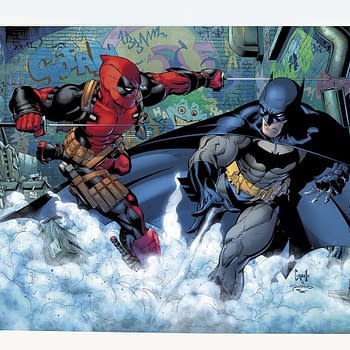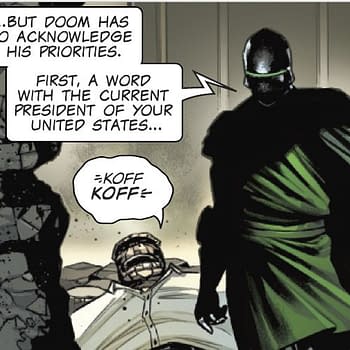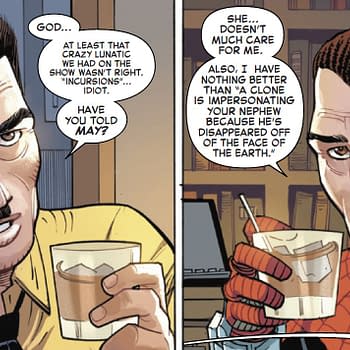Posted in: Comics | Tagged: Ande Parks, Comics, dynamite, entertainment, lone ranger, Writer's Commentary
Writer's Commentary – Lone Ranger #25 By Ande Parks
The Lone Ranger #25 is the final issue in the series from Dynamite and writer Ande Parks gives us a page by page breakdown of the tale from his point of view and says he farewell to the Masked Man.
PAGE ONE
First, the date. I set our series starting in 1870, based on the history of the characters, and on the historical possibilities of that year. Over the course of our run, I wanted The Lone Ranger and Tonto to go though seasons. We had them in fall, winer, spring, etc. One issue featured a snowstorm. So, for our last few issues, I nudged the date up to 1871.
I kept our Lone Ranger further north than he's usually depicted. I don't feel very connected to Texas. I do know and feel connected to Kansas, Colorado and Oklahoma. So, most of our run takes place in those states (or what would eventually become states). I ended us near Denver because I wanted access to herds of buffalo (bison) and I wanted there to be a major city nearby… somewhere tourists could easily travel from.
PAGE TWO
Colonel (I'm proud to say that, after writing this script, I can now type the word "colonel" correctly without pause) Masters is based on Old West showmen: guys like Buffalo Bill Cody, as well as the movie versions of these hucksters. I threw in a dash of Custer form the film "Little Big Man", and Esteve drew our guy exactly as I'd pictured him.
Phillips is our first supporting African-American character in Lone Ranger. Overdue. Given more time, we would have done a story about freed slaves. We just didn't get to it.
This story is based on something I learned about in school: the practice of white people shooting buffalo for sport from passing trains. Of course, this practice was devastating to the Indians who had survived on the herds for generations. I wanted to show that in action, and see how Tonto would respond.

Now we get to our heroes, and to the other side of the buffalo equation. There actually is a historical photo of a mountain of buffalo skulls collected by white men. It is even worse than depicted here. You can check out the photo here: http://www.oobject.com/most-interesting-scrap-yards/buffalo-skull-mountain/7066/
I wanted to emphasize the two different points of view of The Lone Ranger and Tonto. The Ranger is thinking about the plight of the Indians, but he's also thinking about the white man's law. Tonto is only concerned about the dying way of life of his people. Our heroes see things from different angles, but they work together to accomplish the same goals.
I always write with a theme in mind. The overall theme of our entire Lone Ranger body of work is: what drives these two men of such different backgrounds to work together? Our answer is that each has helped the other, in turn, reclaim his humanity after horrific tragedy. That bonds them.
PAGE FOUR
No one draws these western vistas any better than Esteve Polls. We've been so lucky to have and keep him on this book. I can just write "picturesque horizon" and it happens.

Using the Arapaho tribe here is historically accurate. They did live in this region, and they did struggle to survive in this time frame.
Our Chief here is based, once again, on a character from the movie "Little Big Man": Chief Dan George. Esteve draws him really well.
PAGE SIX
I like a couple of things about the dialog on this page. First, the notion that the members of the Arapaho tribe have never tasted beef… it is a foreign concept/taste to them. Second, introducing the concept that the whites kill for the sheer thrill of it, not to survive. Again, this is foreign to the Indians in our story. They are being swept away by forces they cannot possibly understand.
Esteve drew Tonto simply turning his back and walking away, sickened by the crimes of the white tourists. It's a great visual touch.
PAGE SEVEN
The game the Arapaho children are playing is historically accurate.
Tonto is faced in this issue by the dichotomy of his life. He is an Indian who travels with a white man. He may hold his native heritage above all else, but he embraces parts of both cultures. I introduce the proud Arapaho father here to help point out Tonto's internal struggle. Having the father call Tonto a dog is harsh, but it was an efficient way to get all this across.
PAGE EIGHT
The father's story on this page mirrors Tonto's past. There is a part of Tonto that would love to tell the guy off… to explain the suffering Tonto himself has been through, but he sympathizes with the man and his children. In the end, Tonto says nothing, and Lone Ranger comes to break things up.

I have used every opportunity to address The Lone Ranger's faith in our book. He is a devout man, whether he has the opportunity to worship in a church or not. This is, of course, another key difference between The Ranger and Tonto. If Tonto has a faith, it's certainly not based on the same god The Lone Ranger observes.
I am very proud of the Chief's line about The Ranger having chosen his god well. What else could a man say whose gods seem to have forsaken his people?

Back to Masters. He may be a scumbag, but he's a self aware scumbag. He knows the business he's involved in is morally reprehensible. Every night he tries to drink away the guilt. Every morning he pukes up the booze, and the cycle continues. He can't wait for it to end. Unfortunately, things are going to come to a head before Masters has a chance to retire.
PAGE ELEVEN
First, I love the sky in the final panel of this page. Fantastic work by Esteve and Marc.
I really had to wrestle with the logistics of this bit of the story. If the Arapaho drug Tonto and The Ranger, is the whole tribe involved? Why wouldn't they take our heroes' guns? And so on. In the end, I decided the entire tribe did go along with the plan, and that the pride of the father is what kept the guns with The Lone Ranger and Tonto.
PAGE TWELVE
This page is all about the decision the Arapaho chief has made. He is doing something reckless… something that he knows will get his people killed. The plan has little chance of achieving anything concrete, but the chief has decided that it is better to try and possibly fail in glory than to just sit around a campfire and die on the white man's terms.

We jump right into the violence going on at Masters' camp. I flirted with playing this scene with a voiceover, or with sound effects. Playing it silent is risky. You don't want the reader to zip through the page in half a second because there are no words. In the end, I trusted Esteve to make the fight so visually interesting that the reader will naturally want to linger a bit… let the horrific nature of the violence soak in.

This battle scene was very complicated. I knew it would be hard for the reader to get every single beat without hesitation/confusion. In the end, all that really matters is that the Arapaho (justifiably?) attack Masters and his men. In the fight that ensues, Masters shoots and kills the bitter father from the tribe. Tonto is enraged by this new tragedy… driven to avenge the father.
PAGE FIFTEEN
The conclusion of the setup of the climax! Tonto takes down the guy he's been fighting, and then incapacitates Masters. Now… the meat of what this whole issue is about: will Tonto want to kill Masters? This was actually set up over a number of stories we did in this run. Two issues ago, Tonto shot a man through the head because it was the best way to ensure the safety of a hostage. He might have been able to take another way out, but he chose killing.
PAGE SIXTEEN
In issue #24, Tonto more or less kills an unconscious man by leaving him on a fiery train engine car. This man, had he lived, would have been responsible for a lot of deaths: Indians and whites. So… does Masters deserve to die here? It's not a question of justice. It's a question of the greater good. Tonto can't know that Masters is planning to retire… to stop slaughtering buffalo. In Tonto's mind, killing Masters may be the only way to stop the killing and save the entire Arapaho tribe.
Tonto has his dilemma, which in turn creates one for The Lone Ranger.
PAGE SEVENTEEN
We get a taste here of how I think Tonto would be viewed by an average, privileged white person of the time. The Ranger, of course, has outgrown such notions.

It's always dicey to have your hero stand around and lecture people for a page, but I thought it was worth it here. The Lone Ranger is laying out what our entire run of this book has been about: Tonto and The Ranger overcoming their cultural differences because of a basic, shared humanity. There are good men and bad men in the Old West, and color has nothing to do with the distinction.
In the end, The Ranger knows what Tonto's going to do, even before Tonto himself does. He knows his friend is not a cold-blooded killer.
PAGE NINETEEN
The Lone Ranger will not kill. Period. If I'm writing the book, he just will not intentionally take a life. He will always look for the other way out. He would not have shot that man in the head in our previous issue. Tonto did. The Ranger would not. They see things differently. The Ranger is more of an optimist about human nature. This difference is part of why they work so well together. They balance each other.
The Lone Ranger ends Masters' buffalo slaughter here without killing him. It looks that way, at least. If we were to tell Lone Ranger stories indefinitely, we might learn that The Ranger's solution didn't work… that Masters went back to the slaughter because that's all he knew. That would be an interesting story, actually.
PAGE TWENTY
We employ a device here that has become a standard for our book: using text from an imaginary Almanac of the Old West as "history" to contrast the real events of our book. We've used this from time to time since our second issue. I thought it was a great way to end our series.
I wanted to talk about the legacy of The Ranger and Tonto. The whole run has dealt with the power that two men who will not bend can have. By doing good and refusing to compromise, our heroes have affected countless lives over the course of the book. This final sequence demonstrates that.
The farm family (minus the wife) seen here is from our first issue. The mute widow is from issues 3-6 (our first multi-issue arc).

The Ute Indians and Mormons are from our Native Ground arc (issues 7-12). The family saved from the snow is from issue #21 (Blizzard).
We settle here on the final outcome for The Ranger and Tonto. I wanted this to play so you have to read between the lines, so I won't say too much here. Basically, I do see an ending for our heroes in which they get to ride off into the sunset. They do not go down in a hail of gunfire.
PAGE TWENTY-TWO
Of course, I had to end the book with one last chance for Esteve to draw a great, western horizon. He and Marc killed it. What a great way to end our run. The text here talks about what I mentioned above: legacy. The power of good men to shape the world just by doing their best and not quitting.
I have had a wonderful and rewarding experience writing twenty-five issues of this book. I am very grateful to Nick and Joe at Dynamite for giving me the opportunity. I am similarly grateful to the wonderful collaborators I've been so fortunate to work with. In particular, the great Esteve Polls and the amazing Simon Bowland. They have drawn and lettered every single issue, respectability. Gentlemen, it's been an honor. Let's do it again sometime.
Thanks also, of course, to all of you who have supported the book. I hope you've enjoyed the ride as much as we have.
Hi-Yo!
-Ande
For more on the final issue of the Lone Ranger, click here.














